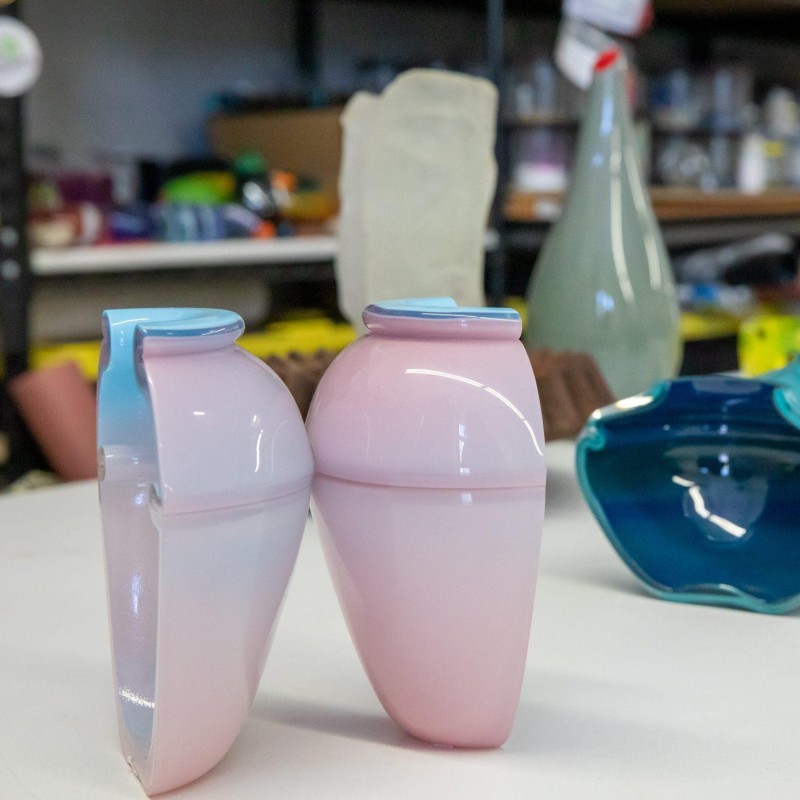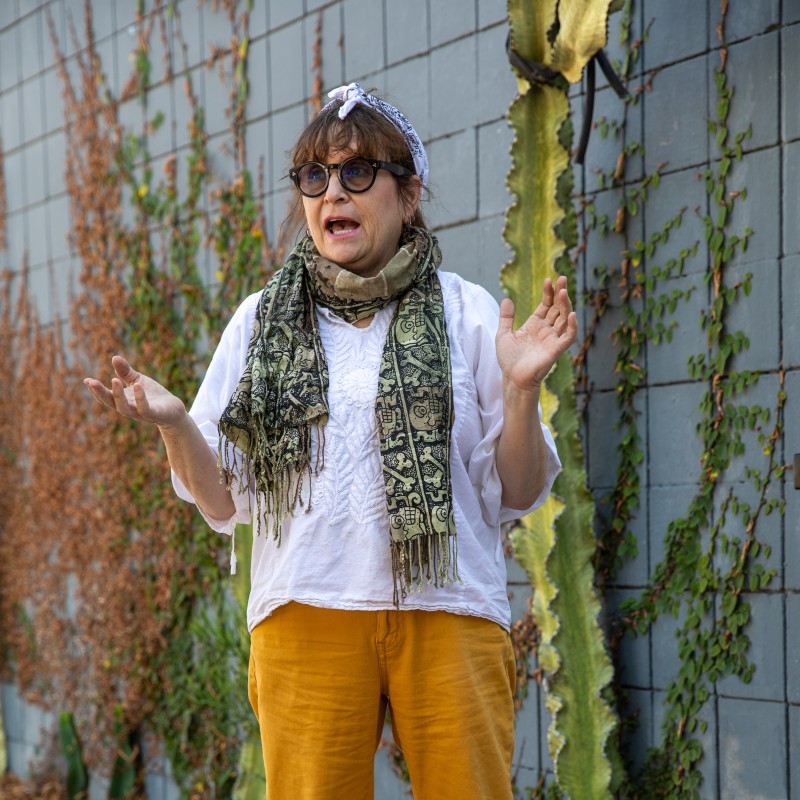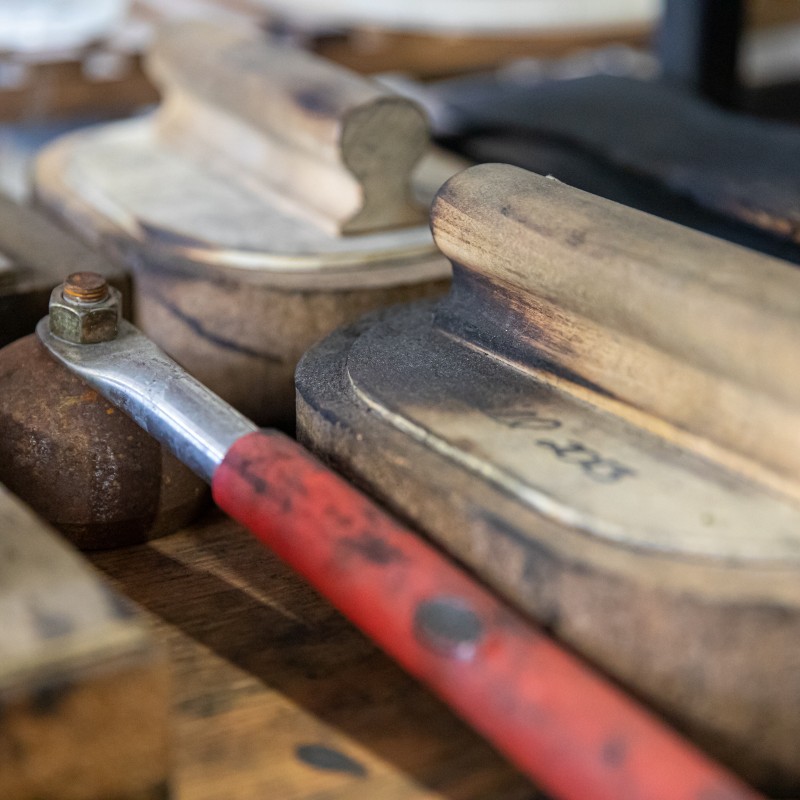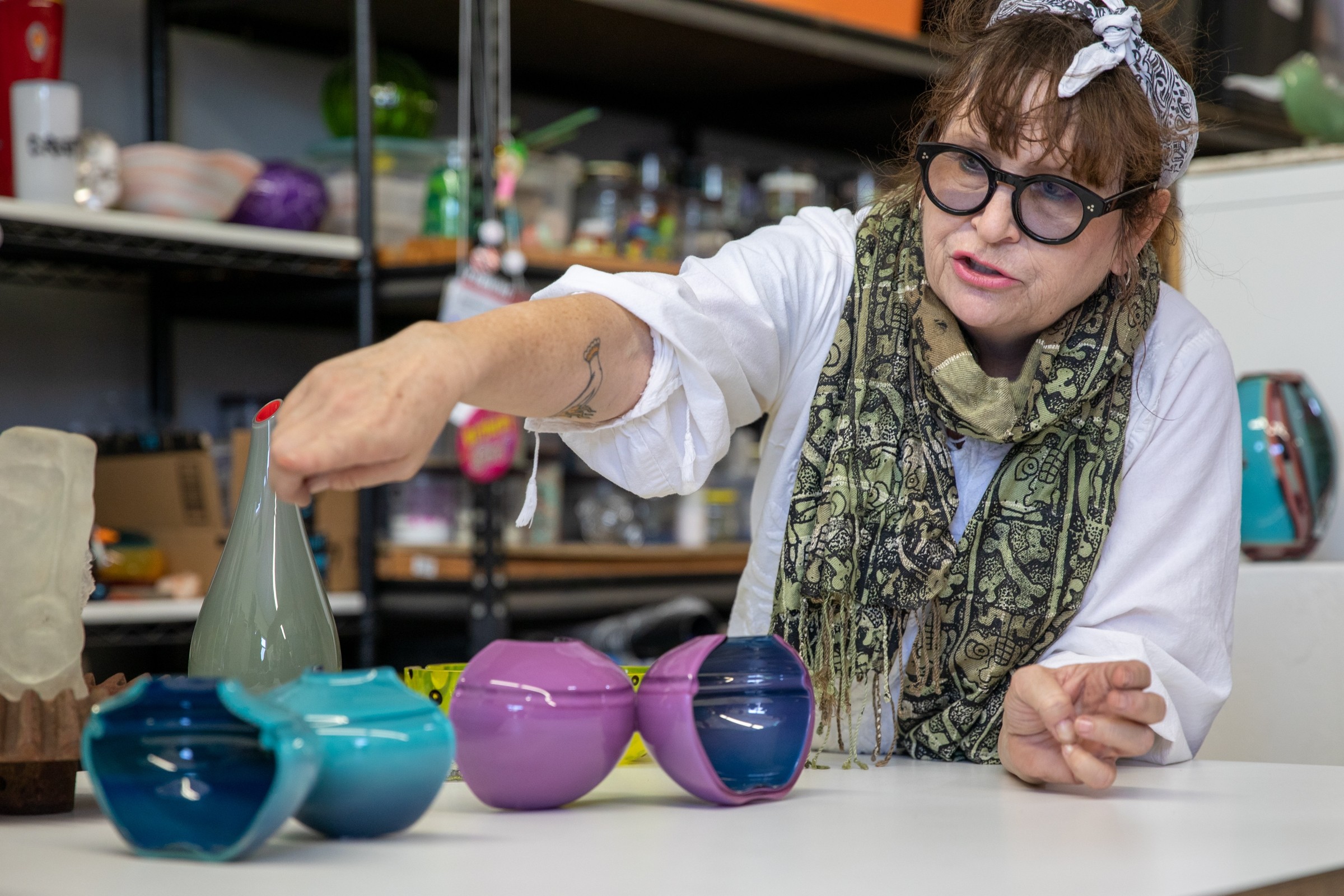Kathleen Mitchell Glass resides in Bread and Salt. At first it was a pure empty rectangle, but she worked with the owner and the city to create the studio it is today. We met Kathleen there on a hot day made hotter by the equipment including a furnace running at 2,100 degrees, a temperature Kathleen referred to as, “pretty warm.”
How did you interpret Metamorphosis, the theme of the Museum’s juried exhibition?
I wanted a craft object to convey my feelings about the word metamorphosis. I have a piece that I started decades ago that is actually named Metamorphosis. When contacted about the show I said, “Where is that piece where is that piece, I know I made that piece!” I got to thinking about these heads that I cast about 35 years ago and put them on the cog maybe 10-15 years ago. I started looking at it and to me it was very external. What I wanted to do was discuss metamorphosis as a more internal thing. So I started looking at deconstructing vessels. These ideas were already happening in my head when you guys reached out to me. It’s kind of crazy! The vessels are blown with the RISD (Rhode Island School of Design) ring, cooled, sliced in half and then glued together "backwards" to expose the inside. The ring is called the RISD ring because it was something that people started at RISD in the 80’s.



Where does this idea of the internal come from?
I teach art in a prison, Richard J. Donovan Correctional Facility. The second-year I was working there we assigned a project to create metaphorical self-portraits. One of the guys sat back in his chair, threw his pencil on the table and said, “that requires introspection and I do not do introspection.” We worked through it and by week two or three he was in there doing his metaphorical self-portrait and he was being introspective, and he was amazing. I started to think about the guys I work with and I see a metamorphosis, I see a transformation, I see this every week that I go in. I have been going there since 2013 and I love what I do, and I love seeing the transformation.
"Glass has a universal language. I have blown glass in many different countries and I can walk in and know how to communicate with others because it’s a visual language. You can move your head or your hands and understand what each other wants or needs. That is a really magical aspect of glass. It is an unspoken language."
These vessels will be in the show, can you talk about your process?
They are deconstructed vessels because I am a glassblower and we make vessels. Normally my work is sculptural assemblage pieces where I combine found objects and blown glass objects together, but my mother died last October after 10 years of just a knockdown drag-out battle with Alzheimer’s that was absolutely horrible, and I couldn’t make work. What I could do was blow glass. I went in every day and had a plan to make something, even if it wasn’t what I consider art, it’s an object and there is emotion involved and there is an investment. I spent the last year making vessels. It was brutal but it was cathartic; it was an expression.
These vessels are one piece that have been split and reattached. They have been revealed. It is talking about metamorphosis in that you can express what is inside of you and look at what is inside of you. They have an enormous failure rate. I have a huge box of broken ones. Maybe one-third of them survive because of all the stress you put on them. You blow them, create this ring, do the cold work and then you cut them in half. It is stressful for glass to be sliced in half. This process is all about exposure, all about what is inside.
How often do you work at Richard J. Donovan Correctional Facility?
I am there two nights a week. It is intense work, but it is gratifying work. Prison, I will say, is a lot like junior high school. It is gossipy. The yard I am on right now is the sensitive needs yard. There are gang members who are trying to get out of gangs, possibly somebody who has an unpaid drug bill that someone may kill them for. There are transgender individuals, there are pedophiles. They are people who might be murdered on any other yard. To see them become vulnerable, really made me think about metamorphosis inside versus the external metamorphosis that I was thinking about 35 years ago, how we change our exterior. Now it is more about how we change our interior and how we expose ourselves and become more comfortable with that.

The halves are fused together, is that another magic?
It is a magic… called glue. We jokingly call it cold fusion, but it is really glue. There are many types of adhesives. One piece is on its fourth glue up because the other glues just weren’t working. I was so stressed about this. Some objects have ultraviolet glue and some have epoxy.
What is it like being one of the only hot shops in San Diego?
It is interesting. We all know each another, and we are all friends, to a degree, but the idea that glass blowing has always been a very male-dominated field drives this shop. I was really compelled to make a women-centric shop and it always has been. I mean guys work here too, but they understand that there is equal footing. When I was working in Murano, people would peek around the corner in shock that a woman was blowing glass. If anyone has seen the Netflix show Blown Away there is a woman who is a little younger than me, but she came up in the same environment, where there was a lot of sexism and disrespect for women in the hot shops. You weren’t given the good jobs. You weren’t taking the seat on the bench. You were always an assistant. I really felt that it was important to break that. To stop it.
You do team building and classes here, how is that?
I am so grateful and fortunate to know how to do this ancient form of art, this craft, and I feel like it is my responsibility to put it out there. There are so many people who have trade secrets and are keeping everything inside and I say no! I just want to share everything. I don’t teach people how to make my work. I teach people how to blow glass. Once someone understands the material and the challenges, then they can go make their own work.
In glass blowing there is lots of physics, lots of chemistry, lots of fearlessness and fun. It is super crazy and fun stuff but you have to know your science. You have to be brave, you have to have a sense of adventure you have to like chemistry and physics. If I put my tools up on the bench, and you walked into the glass museum on Murano, you would see tools that look almost identical to these. From 1200 to today everything is pretty much the same, the only thing that's changed is technology.
Glass has a universal language. I have blown glass in many different countries and I can walk in and know how to communicate with others because it’s a visual language. You can move your head or your hands and understand what each other wants or needs. That is a really magical aspect of glass. It is an unspoken language.
That is my passion. I love blowing glass, I love teaching glass blowing, I love prison, I love art.






